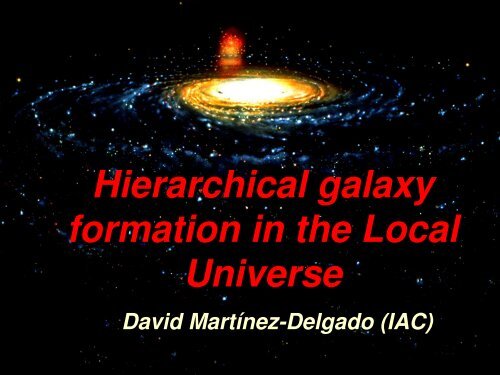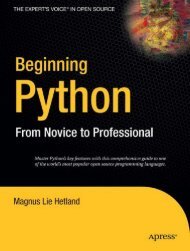Hierarchical Galaxy formation in the Local Universe
Hierarchical Galaxy formation in the Local Universe
Hierarchical Galaxy formation in the Local Universe
You also want an ePaper? Increase the reach of your titles
YUMPU automatically turns print PDFs into web optimized ePapers that Google loves.
<strong>Hierarchical</strong> galaxy<br />
<strong>formation</strong> <strong>in</strong> <strong>the</strong> <strong>Local</strong><br />
<strong>Universe</strong><br />
David MartínezDelgado (IAC)
Nbody model “maker”:<br />
J. Peñarrubia (Univ. Victoria, Canada)<br />
The SDSS collaboration for Galactic Structure:<br />
Mario Juric (Pr<strong>in</strong>ceton), Z. Ivezic (Pr<strong>in</strong>ceton), H. W.<br />
Rix (MPIA), H. Newberg (RPI)<br />
Also starr<strong>in</strong>g:<br />
E. J. Alfaro (IAA), S. R. Majewski (Virg<strong>in</strong>ia Univ), Ignacio<br />
Trujillo (Nott<strong>in</strong>gham), Jay R. Gabany (Cosmotography)
At high redshift, we can follow <strong>the</strong> evolution of <strong>the</strong> stellar<br />
population of galaxies, but not <strong>the</strong> process of assembly<br />
of <strong>the</strong> components (halo, disk) of <strong>in</strong>dividual systems.
THE FORMATION OF THE MILKY<br />
WAY<br />
Searle & Z<strong>in</strong>n (1978)<br />
<strong>Hierarchical</strong> galaxy<br />
<strong>formation</strong> <strong>in</strong> CMD<br />
cosmology (present)
Bullock (2003)<br />
Outer regions of galaxies<br />
conta<strong>in</strong>s <strong>the</strong> fossils of <strong>the</strong><br />
hierarchical galaxy <strong>formation</strong>
Mt. Hopk<strong>in</strong>s, 1.3m<br />
Uniform scan of <strong>the</strong> 70% of <strong>the</strong> sky<br />
J,H,K filters, K~14.3<br />
New Mexico, 2.2m<br />
Imag<strong>in</strong>g: 7500 deg 2, |b| > 30°<br />
u'g'r'i'z' filters, r~22.5
Streams resolved<br />
<strong>in</strong> stars. SB~30.5<br />
mag/arcsec 2<br />
CMD provides positions,<br />
distances, targets for Vr<br />
Nbody simulations<br />
build <strong>the</strong> dynamical<br />
history of <strong>the</strong> stream
The tidal stream of <strong>the</strong> Sagittarius dwarf<br />
galaxy<br />
25 kpc<br />
Discovered by Ibata et al<br />
(1994) at 16 kpc from <strong>the</strong><br />
center of <strong>the</strong> Milky Way
Mart<strong>in</strong>ezDelgado et al. 2001<br />
AN ALL SKY VIEW OF<br />
THE SGR STREAM!!<br />
Majewski et al. 2003<br />
Belokurov et al. 2006<br />
Mv=13.3; M/L~25<br />
15% mass <strong>in</strong> tidal stream !
The Virgo stellar overdensity:<br />
a new Milky Way satellite?<br />
“The SDSS reveals a new Milky Way neighbor”<br />
Photometric parallax<br />
distances of 48 million<br />
stars (Juric et al. 2006)<br />
Mart<strong>in</strong>ezDelgado et al. 2006<br />
z<br />
~1000 square degress<br />
(Juric et al. 2006)<br />
R<br />
PRESS RELEASE January 9 th , 2006:
Virgo<br />
Stellar overdensities <strong>in</strong><br />
Virgo were associated<br />
with a cross of Sgr tidal<br />
tails at 20 kpc predicted<br />
by <strong>the</strong>oretical models…<br />
but never observed…<br />
Law et al. 2005
What is <strong>the</strong> best Sgr stream model?<br />
Sgr tidal stream has been used to constra<strong>in</strong> <strong>the</strong> shape of <strong>the</strong> dark matter halo of <strong>the</strong> Milky<br />
Way (Johnston et al. 2005; Helmi 2004; Law et al. 2005;Mart<strong>in</strong>ezDelgado et al. 2004)<br />
But <strong>the</strong>re is not a perfect model!:<br />
Radial velocities of <strong>the</strong> Sgr lead<strong>in</strong>g arm<br />
can only fitted with a prolate halo model<br />
(Helmi 2004)<br />
Johnston et al. (2005) f<strong>in</strong>d prolate halos cannot reproduce <strong>the</strong> precession<br />
rate <strong>in</strong> <strong>the</strong> youngest pieces of <strong>the</strong> Sgr stream (exclud<strong>in</strong>g models with q>1)<br />
For our comparison, we will explore both cases: q=0.8<br />
(oblate halo)<br />
q=1.4 (prolate halo)
q h<br />
=0.8<br />
q h<br />
=1.4<br />
(l,b) obs<br />
~(290,65)<br />
Mart<strong>in</strong>ezDelgado et al. 2006
SDSS<br />
tomography q h<br />
=0.8 q h<br />
=1.4<br />
Y<br />
X X X<br />
Z<br />
Mart<strong>in</strong>ezDelgado et al. 2006<br />
R R R
q h<br />
=0.8 (oblate) q h<br />
=1.4(prolate)
A highway of dark matter cross<strong>in</strong>g <strong>the</strong> solar<br />
vec<strong>in</strong>ity: a wonderful target for dark matter<br />
detection experiments ( DAMA)
The Monoceros tidal stream<br />
A giant stellar r<strong>in</strong>g<br />
surround<strong>in</strong>g <strong>the</strong> Milky<br />
Way disk at 16 kpc<br />
(Newberg et al. 2002)<br />
Only visible at low<br />
galactic latitude (|b|
The nature of lowlatitude stellar<br />
structure is controversial: Galactic<br />
feature or satellite accretion?<br />
Low <strong>in</strong>cl<strong>in</strong>ation, circular<br />
satellite orbits are very unlikely<br />
<strong>in</strong> <strong>the</strong>oretical models based on <strong>the</strong><br />
CDM <strong>the</strong>ory.<br />
Is <strong>the</strong> Monoceros r<strong>in</strong>g <strong>the</strong><br />
signature of <strong>the</strong> Galactic flare or<br />
<strong>the</strong> outer region of <strong>the</strong> MW warped
A comprehensive model of <strong>the</strong> Monoceros Stream<br />
An extraord<strong>in</strong>ary<br />
observational effort <strong>in</strong><br />
<strong>the</strong> last year for<br />
different groups to<br />
trace this stream.<br />
Best orbit obta<strong>in</strong>ed<br />
us<strong>in</strong>g semianalitical<br />
model from fitt<strong>in</strong>g to<br />
position, distance and<br />
velocities of stream<br />
stars (151200<br />
simulations)<br />
Nbody simulation for<br />
<strong>the</strong> best orbit, <strong>in</strong>clud<strong>in</strong>g<br />
dynamical friction<br />
<strong>in</strong>cluded<br />
Observational data consistents with a huge tidal stream<br />
disrupted <strong>in</strong> <strong>the</strong> last 2.5 Gyr
Radial velocities are<br />
not enough to constra<strong>in</strong><br />
<strong>the</strong> sense of motion of<br />
<strong>the</strong> orbit: Proper<br />
motions from SDSS<br />
were used to constra<strong>in</strong><br />
orbital motion<br />
A low <strong>in</strong>cl<strong>in</strong>ated (i= 20 ±5º),<br />
almost circular (e=0.10±0.05),<br />
PROGRADE orbit<br />
Distance and<br />
k<strong>in</strong>ematical data are<br />
not enough to constra<strong>in</strong><br />
<strong>the</strong> position of <strong>the</strong> ma<strong>in</strong><br />
body of <strong>the</strong> parent<br />
galaxy: progenitor can<br />
be <strong>in</strong> 100 >l >200<br />
Peñarrubia, MartínezDelgado, Rix et al. 2005,<br />
ApJ, 629,85
Observed SDSS<br />
Nbody model<br />
Grillmair (2006) reports <strong>the</strong> discovery of a coherent 60ºlong<br />
unknown tidal stream <strong>in</strong> <strong>the</strong> Galactic Anticenter.<br />
However, we f<strong>in</strong>d a excellent agreement with <strong>the</strong> Monoceros<br />
tidal stream Nbody model: <strong>the</strong> first panoramic view of this<br />
outer stellar r<strong>in</strong>g.
RR Lyr clump<br />
Anticenter stream<br />
([Fe/H]=1.3)<br />
Progenitor position:<br />
CMa dwarf [Fe/H]=0.4<br />
A cross of 2<br />
different tails<br />
THE MONOCEROS STELLAR RING IS THE TIDAL STREAM OF A<br />
SATELLITE IN A PROGRADE CIRCULAR ORBIT. ITS ORIGINAL STELLAR<br />
POPULATION IS METALPOOR AND OLDER THAN THE MW DISK.<br />
(Peñarrubia, MartínezDelgado, Rix 2007)<br />
No metallicity gradient outside R gc<br />
=10 kpc: merger are play<strong>in</strong>g an important<br />
role <strong>in</strong> <strong>the</strong> outer disk <strong>formation</strong> of <strong>the</strong> Milky Way. A survival “build<strong>in</strong>gblock”?
• Stellar Tidal Stream:<br />
(edgeon galaxies)<br />
• What is <strong>the</strong> role of <strong>the</strong>se processes <strong>in</strong> <strong>the</strong> <strong>formation</strong> of <strong>the</strong><br />
halos and <strong>the</strong>ir globular cluster systems?<br />
• Extended outer disks:<br />
<br />
• Is observed halo substructure degree consistent with <strong>the</strong><br />
CMD <strong>the</strong>ory simulations? Where are <strong>the</strong> “miss<strong>in</strong>g satellites”?<br />
• Can tidal debris expla<strong>in</strong> <strong>the</strong> metalrich halos? Can we trace<br />
<strong>the</strong> dark matter around neaby spirals with tidal streams?<br />
(faceon galaxies)<br />
• Are extended disk of spirals formed via satellite acretion?<br />
• What are <strong>the</strong> mechanisms of star <strong>formation</strong> <strong>in</strong> <strong>the</strong>se very low<br />
density galactic regions? Are <strong>the</strong>y older than <strong>the</strong> normal disks?
Tidal streams<br />
“Extended disks”<br />
Nearby massive spiral<br />
galaxies provide an<br />
external view of <strong>the</strong>se<br />
merger events observed<br />
<strong>in</strong> <strong>the</strong> Milky Way<br />
M104<br />
M83<br />
M31<br />
M94
A river of stars <strong>in</strong> <strong>the</strong> M83 halo<br />
VIMOS VLT<br />
MartínezDelgado<br />
PI.<br />
Subarcsecond imag<strong>in</strong>g<br />
provided by 8 meterclass<br />
telescope allows to resolve<br />
stellar streams and extended<br />
disks <strong>in</strong> spiral galaxies with<strong>in</strong><br />
5 Mpc (HSTACS 11 Mpc)
MartínezDelgado et al. 2007<br />
Sacket (1995) reported a metalrich<br />
halo, but fields are contam<strong>in</strong>ated by<br />
tidal debris.<br />
Complex structure expla<strong>in</strong>ed by one<br />
merger 4.5 Gyr ago: an unprecedent<br />
view of a multiwarp old tidal stream<br />
Progenitor survived! Possible<br />
hidden beh<strong>in</strong>d <strong>the</strong> disk.
THE FORMATION OF THE OUTER EXTENDED DISKS<br />
Theoretical model shows that<br />
extended disk around spiral<br />
galaxies could be formed by<br />
accretion of a dwarf satellite<br />
Peñarrubia et al. 2006<br />
MartínezDelgado et al. 2007
There is an excellent agreement between <strong>the</strong> observations of <strong>the</strong><br />
Monoceros stellar r<strong>in</strong>g and Nbody simulations of tidal<br />
disruption of a dwarf satellite <strong>in</strong> a low <strong>in</strong>cl<strong>in</strong>ated, almost circular<br />
prograde orbit. The stellar population of this stream support <strong>the</strong><br />
extraGalactic orig<strong>in</strong> of this structure, reject<strong>in</strong>g that it is a<br />
Galactic feature.<br />
We provide evidence on <strong>the</strong> presence of <strong>in</strong>fall of <strong>the</strong> Sgr<br />
lead<strong>in</strong>g tail onto <strong>the</strong> Galactic disk. This would expla<strong>in</strong> <strong>the</strong> giant<br />
overdensity discovered <strong>in</strong> Virgo.<br />
The study of tidal streams and extended disks <strong>in</strong> spiral galaxies<br />
<strong>in</strong> <strong>the</strong> <strong>Local</strong> <strong>Universe</strong> will allow to extend this research on <strong>the</strong><br />
<strong>formation</strong> of <strong>the</strong> components of spiral galaxies.
Halo <strong>formation</strong> z~15<br />
Disk <strong>formation</strong> z~2<br />
At high redshift, we can follow<br />
<strong>the</strong> evolution of <strong>the</strong> population,<br />
but not <strong>the</strong> evolution of<br />
<strong>in</strong>dividual systems<br />
The “miss<strong>in</strong>g satellite” crisis of<br />
<strong>the</strong> Cold Dark Matter<br />
Cosmology

















